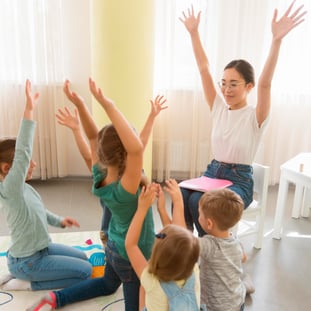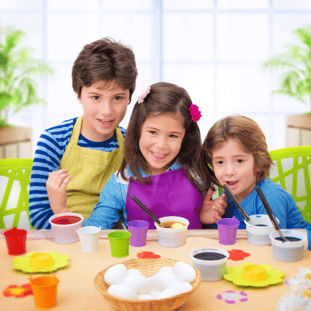It's Time To Rename Brain Breaks
Don't get us wrong - brain breaks are fantastic for kids and bring measurable benefits to the classroom, including longer attention span, less fidgeting, and higher overall learning outcomes across grade levels - but we need to stop calling these activities "brain breaks."
FIRST AND FOREMOST: WHAT IS A "BRAIN BREAK?"
Put simply, a brain break is a movement opportunity that allows kids to get up from their seats and move their bodies between long periods of time at their desks.
WHAT'S WRONG WITH A BRAIN BREAK? IT SEEMS GREAT!
Brain breaks are great - but there's a catch.
According to Timothy D. Davis, Ph.D. CAPE, Director of the Sensory Motor Integration Lab at SUNY Cortland, a "brain break" implies the brain is taking a break from learning, which is not at all what proponents of "brain breaks" actually mean.
"As I consult around the country, I often come across terminology such as sensory breaks, brain breaks, and sensory diets," said Davis, in an email to Fit and Fun Playscapes LLC. "These terms are all very similar and represent a variety of activities designed to help children improve focus, regulate behavior, and find homeostasis or balance to enhance integration and processing of their sensory systems."
"However, I often wonder what kids think when they hear 'Okay students, now we are going to do a brain break activity,' or when teachers say 'That student is on a sensory diet' or “that student is struggling, so let’s send them for a sensory break.'"

IT'S TIME TO CHANGE THE TERMINOLOGY
According to Dr. Tim, terms like "brain breaks," "sensory diets," and even "sensory breaks" can actually confuse children into thinking they are going on a break from learning.
"When asked [what a brain break is]," said Davis, "the children I have spoken to respond with 'Oh, that’s when we get to turn our brains off and let it rest.' Or, the best: when 'that kid' gets a sensory break, he gets to leave the room and doesn't have to learn anymore.' These are all actual quotes from children and fly contrary to teaching children how to self-regulate their bodies by stimulating their brain through the senses."
This concept is extremely important for three primary reasons.
First and foremost, children are not supposed to think they are taking a break from learning when they engage with a sensory movement opportunity (such as a sensory pathway, sensory hallway, or sensory corner). Instead, the sensory movement opportunity is meant to be a quick five to 15-minute exercise designed to re-ground the child's senses, thereby making them more receptive to learning and re-focusing their attention.
It is not, again, a "learning break" and should not be taught or utilized in a way that makes other children think a specific child "doesn't have to learn anymore" when they use these breaks.
In fact, teaching or giving movement opportunities in the above manner can actually lead to children acting out in the classroom, since "bad behavior" (such as fidgeting, talking, sleeping, or even emotional outbursts) is being negatively reinforced by the educator. Children who don't want to sit still in the classroom anymore may begin to purposefully act out because they know they'll be able to go in the hallway for a few minutes - which is not the purpose of a sensory pathway, sensory hallway, or sensory corner.
Second, teaching or discussing movement opportunities in the manner of "learning breaks" or "brain breaks" can cause decision-makers at the school and district-wide levels to think sensory pathways, sensory hallways, or sensory corners are nothing more than recess - which means they are less likely to allocate the school's budget to accommodate them. Instead, incorporate movement opportunities in the same way you would plan a math, reading, or writing lesson.
Plan a series of movements for one week (say, hopscotch, cross midline, or bear crawl) have the students complete the exercises in a specific order. Then, during the following week, have them perform the movement routine backwards, or in a different order. This way, the movement opportunity on a sensory pathway, or in a sensory hallway or sensory corner, is seen as a part of the lesson plan and not a "break" from it.
Third, movement opportunities are important for both children and adults - Dr. Tim explains why.
"As adults, we are able to seek out the sensory input we need to help us stay calm and regulate," said Dr. Tim Davis. "However, children don’t always have the independence, or ability, to know what exactly they need. Teachers should be trained to understand sensory input and processing In order to best meet the needs of their students."
In other words, Dr. Davis is calling for teachers (or relevant educators) to have training in order to recognize the specific sensory needs of their students. This training needn't be intense - just a baseline ability to recognize which movement opportunity is right for which specific circumstance.
"Everyone is unique - so too are our sensory systems," wrote Davis. "Some children need heavy proprioception to find homeostasis in their body while others seek out tactile or vestibular activities to help them feel in control [of their bodies]. However, our sensory needs change throughout the day. Providing multiple sensory opportunities across the day is the key to helping children learn to self regulate and be confident in their shoes wherever they play."

CONCLUSION
In summary, we need to stop calling movement opportunities "brain breaks." Even though the term is catchy and easy to remember, it can detract from the value that a "brain break," if you will, actually provides for children - particularly children with sensory processing disorders. Specifically, it is important that children recognize the sensory opportunities provided by sensory pathways, sensory hallways, or sensory corners are not "breaks" from learning, but are instead continuations of learning - just through a different medium. This point can be especially important when pitching the idea of a sensory hall or sensory corner to a school administrator, since many admins might find the investment easier to swallow (and thereby, explain to parents and the PTA) if they understand that their new hallway isn't just an excuse for kids to "miss class."
So, instead of "brain break," Dr. Tim recommends using the term sensory opportunity - because, in his words, "sensory = brain processing." Brain boost is another great term.
What do you think about the term "brain break?" Do you like the term? Why or why not?
Updated 3/23/2022




Leave a comment